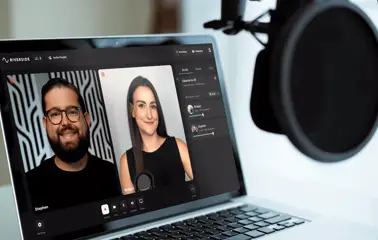#9 tips for a seamless video interviewing process
Are you prepared to explore the realm of video interviews but uncertain about how to leverage them to your advantage? You can increase recruiting efficiency by using video interviews, but it's important to trust the process. Today, Aniday will explore 9 tips for a seamless video interviewing process for both you and the candidate.

1. Transform Your Company's Approach to Video Interviews
Video interviews are a valuable asset to your recruitment strategy, provided you establish an effective process. Is your company still holding onto the misconception that the only way to evaluate a candidate is through a physical handshake? It's time to dispel your doubts about video interviews and recognize their cost-effective capacity to efficiently assess a broader range of candidates.
This approach extends our talent search beyond geographical boundaries, eliminating the need to incur expenses for candidates' long-distance travel.
2. Empower Candidates to Schedule Their Interviews
Scheduling interviews can be a time-consuming hassle for both you and the candidates. Instead of engaging in prolonged back-and-forth discussions over potential time slots, streamline the process with an interview scheduler to save time.
We've recently introduced an integration with Calendly, enabling Greenhouse users to set their availability. This allows candidates to select the most convenient interview time, and both parties receive notifications when a slot is booked. This system is particularly well-suited for remote interviews across various time zones.
3. Ensure Familiarity with Your Chosen Software

It's essential that all participants are well-acquainted with the software you've selected for the interviews. There's a plethora of platforms available for hosting interviews, so candidates should be informed in advance about where the meeting will take place. This allows them to download the necessary software or access the website before the interview.
Furthermore, it's crucial to clearly communicate that video participation is an integral aspect of the interview process. Many tools provide the option for users to call in or disable their cameras, so if you prefer to have visual interactions with your candidates, ensure this expectation is made clear.
In terms of technology, we recommend utilizing a tool like Zoom for hosting video meetings. It's a versatile resource suitable for companies of all sizes, offering a free account to start and the option to upgrade for more features. One-on-one meetings are free, making it an ideal choice for interviews.
4. Streamline Pre-Interview Notifications
People can easily lose track of time, especially when they don't have to physically travel to an interview location. While video interviews are time-efficient, their success depends on all participants showing up as planned. To minimize the risk of missed interviews and wasted time, automate pre-interview reminders.
Set reminders at least 24 hours and one hour before the scheduled interview. While some employers opt for reminders just ten minutes before the meeting, it's essential to consider that ten minutes might not provide candidates with adequate time to prepare and present their best selves on camera.
5. Craft Relevant Interview Questions
Effective interview questions are at the core of successful interviews. Tailor your questions to reflect the competencies you value in your employees. Consistency is key, so use the same questions for candidates vying for the same role. This ensures comparability and helps maintain a structured interview process.
6. Test Your Technology
Testing your technology is a simple yet crucial step. Familiarize yourself with the interview platform and ensure your camera, lighting, microphone, and headphones are set up correctly. If conducting the interview from a new location, check your internet speed to avoid disruptions. A smooth video interview experience is essential for both you and the candidate.
7. Choose the Right Interview Setting

Crafting the right interview questions is a pivotal aspect of the interview process. Questions serve as the core of every successful interview, but formulating meaningful ones is easier said than done. How can you ensure that your questions assist in identifying the ideal candidates while shedding light on their strengths and weaknesses?
Your interview questions should revolve around the competencies you desire in your employees. For instance, if workplace honesty is a core value, some questions should delve into your candidates' perspectives on honesty. It's essential to align your questions with the values upheld by your company and the specific requirements of the role in question.
Another vital interviewing technique is employing uniform questions for all candidates applying for the same position. Consistency in questioning ensures clean data for making candidate comparisons. It's crucial to stay on course and avoid deviation during the interview process.
8. Implement a Structured Interview Process
To achieve a seamless interview process, standardize it. Your goal should be to minimize variability in hiring decisions based on the interviewer. Tools like Greenhouse can help establish a fair and organized hiring process, including the use of a hiring scorecard. This structured approach allows interviewers to make decisions based on predetermined criteria rather than relying solely on intuition.
Video interviews, coupled with a structured hiring process, can significantly boost recruiting efficiency and lead to consistent, high-quality hires year after year.
9. Ensure Candidate Comfort by Providing Expectations, Timelines, and Virtual Background

Many job seekers feel anxious and stressed, especially when facing virtual interviews. To put your candidates at ease, proactively reach out to them with comprehensive information about their virtual interviews, just as you would if they were attending in-person meetings.
Here's what you should communicate:
-
Guidance on accessing the video-conferencing technology and any required software downloads.
-
Clearly defined expectations for the interviews, including whether the interviewer may request a work sample or an on-the-spot problem-solving task.
-
A detailed timeline outlining the start and end times of each interview and the names and job titles of all interviewers, along with links to their LinkedIn profiles.
-
As a precaution, provide a backup phone number for candidates to reach you in case of technical issues. Request them to share their backup contact as well.
-
Consider supplying the same virtual background to all candidates to mitigate "background bias," which can unfairly impact candidates based on their home settings.
By offering these details, you'll create a more comfortable and equitable virtual interview experience for your candidates.
Utilizing a platform such as Aniday enables you to establish an equitable and well-structured hiring process. For instance, you can generate a hiring scorecard, facilitating the effective evaluation of candidates. This approach replaces subjective decision-making during interviews with a predefined set of criteria based on values and skills.
Video interviews represent an excellent method for enhancing the efficiency of recruiters and interviewers. When you combine 8 tips for a seamless video interviewing process with methodical hiring strategies, you can elevate your recruitment function, ensuring a consistent influx of exceptional hires year after year.
Aniday's HR Services
Headhunting Service
Find and recruit quality candidates in just 1 week! Supported by 40,000 experienced headhunters in IT, Finance, Marketing… capable of recruiting in any region.
Headhunting Service ➔Employer of Record (EOR) Service
On behalf of your business, we recruit employees and handle payroll without the need to establish a company in markets such as Vietnam, Singapore, Malaysia, India, Indonesia…
Employer of Record (EOR) Service ➔